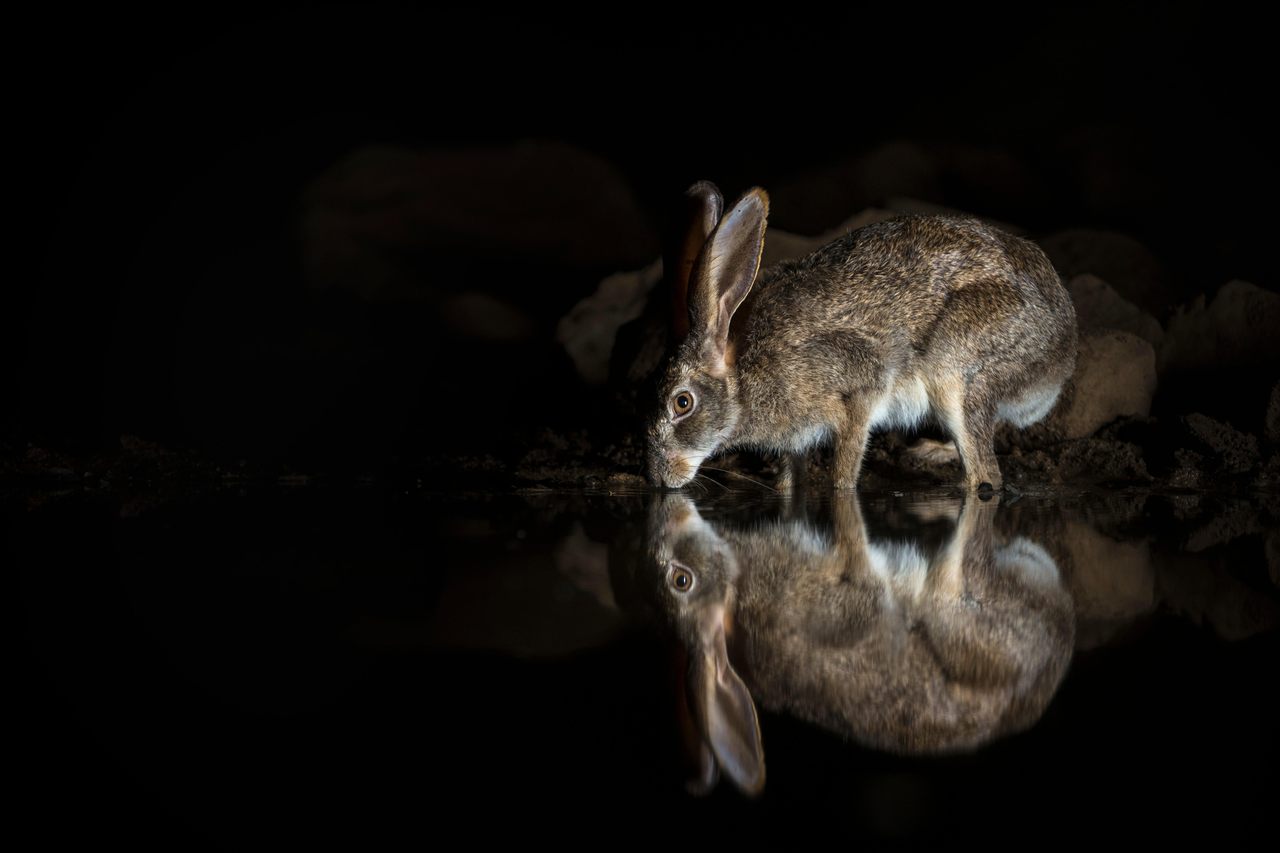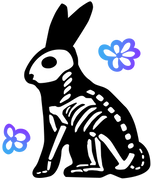Rabbits Are Creatures of the Underworld According to Ancient Fears
From Ancient Egypt to ‘Donnie Darko’, beware the bunny.
Fuzzy tails, wide eyes, long and distinguishable ears, and an ever-twitching nose—the rabbit seems fairly unassuming at first glance. Yet ancient beliefs about the Leporidae family refer to the creature as something crafty, otherworldly, and a bit spooky.
It turns out rabbits provoke an ancient fear, one that has rippled in civilizations across the globe, from ancient Egyptians to Celtic peoples. For many, it’s okay, maybe even wise, to be afraid of bunnies.
For the Irish in particular, hares are considered devious creatures. Despite being in the same family, there’s a distinction between rabbits and hares. It’s something Kelly Fitzgerald, Head of Irish Folklore & Ethnology at the University College Dublin, is quick to differentiate.

“Hares are much larger; they’re born with fur and their eyes open. They enter the world ready to fight,” she says, unlike the “softer, cuter, more vulnerable” rabbit. Hares are also native to Ireland, while rabbits arrived with the Normans in the 12th century.
“The hare has never been domesticated, but man is dependent on it,” Fitzgerald points out. “It is part of man’s world but not quite.”
The aloofness of the hare has bestowed him with a certain mysticism in Old Irish belief, explains Fitzgerald, and “a sense of the supernatural and connection to the other world.”
A well-known Irish lore called The Stealing of the Milk Profit describes a farmer who spots a hare suckling the milk from his cows. The farmer shoots the hare in the leg and chases after the limping creature, following it into a burrow.

Underground, the farmer finds a wounded woman, bleeding from the leg. The tale ends here, with the ominous realization that the creature is actually a witch. It’s one variation of the hag and hare folklore, which has several iterations throughout northern Europe.
“In Irish tradition, humans have the ability to shapeshift into animals such as the hare,” Fitzgerald explains.
This tale of the transfigured woman happens at “the most magical time,” according to Fitzgerald: May 1. Also known as May Day, it’s an important time in the Celtic year that marks the start of harvest, but also invites otherworldly beings.

“May Day is exactly half a year from Halloween, the end of the harvest. These two days have the thinnest veil between this world and the other world,” says Fitzgerald, explaining that these particular dates blur the boundaries between reality and the supernatural.
While the hare wasn’t a particularly feared figure among Old Irish agricultors, it was respected as a clever, cryptic animal that wouldn’t be hunted or consumed for meat. Fitzgerald says the ominous hare in the story gives a sense that “people are out to get you, performing bad magic on you.”
Hares were also ritualistically buried in human graves in Neolithic tombs in Ireland. Tied to fertility and renewal, the fuzzy creatures played a role in ancient death rites.
With hundreds of different Leporidae species indigenous to all continents except Antarctica and Oceania, the hare is also present in Ancient Egyptian narratives—where it’s even more tied to the underworld.

The Ancient Egyptians paid great attention to the afterlife, believing in the importance of rituals such as mummification and offerings to ensure life after death, as evidenced by the elaborate tombstones and sacred burial sites. After dying, subjects had to pass judgment by Osiris, the Ruler of The Dead. Osiris either blessed subjects with passage to the afterlife or damned them to decimation by grizzly devourment.
“You will occasionally see hare-headed gods in a group of other deities in the Judgment of the Dead scene, where you have a council of deities,” says Nicky Nielsen, an Egyptologist at Manchester University.
There is also literature that depicts Osiris with the head of a hare.

“According to Plutarch, the Egyptians venerated the hare on account of its swiftness and keen senses, but the animal’s form was also taken by certain underworld deities,” writes Richard H. Wilkinson in The Complete Gods and Goddess of Ancient Egypt.
Wilkinson notes that the hare also embodied the Goddess Wenu and her male counterpart Wenenu, the latter “sometimes identified as a form of Osiris.” The fluffy critter and death seemed to go hand-in-hand.
Pagans, Greeks, and Ancient Romans all believed hares were a symbol of fertility, even associating them with Aphrodite, leading to today’s Easter Bunny figure. The hare’s association with birth naturally links it to death; it became invoked as a symbol of resurrection. This could explain the hare’s association with Osiris, who was resurrected after death.
But it seems leporiphobia isn’t only a thing of the past. Scary rabbits and hares continue to be a staple in contemporary narratives. In Lewis Carroll’s Alice in Wonderland, an infamously delirious “Mad March hare” takes on the frenzied, excitable breeding behavior of the hare in spring. In the cult, B-movie horror flick Night of The Lepus’ from 1972, a community attempts to cull their proliferating wild rabbit population with a hormonal serum. The experiment accidentally transforms the animals from nuisance breeders into massive, flesh-eating monsters. The feral rabbits then eat the humans.

And the 2001 outsider opus Donnie Darko features the creepy character, Frank, who is metaphorically depicted as both man and rabbit. “Why are you wearing that stupid Bunny suit?” Donnie asks him, to which he replies, “Why are you wearing that stupid man suit?” In the film, Frank wears a scary bunny costume and is killed on Halloween. Yet the bunny takes on a supernatural role as Frank, in full rabbit gear, appears as an unliving form that only Donnie can see, guiding him to the afterlife.
Leporidae have qualities that continue to mystify and fascinate us. Whether it be swiftness, fertility, or their underground habitats, they possess something inherently unhuman, giving them an incomprehensible quality.
For Fitzgerald, understanding animals through otherworldly attributes, as the Old Irish did, makes perfect sense.
“Western society today is so disconnected from the natural world. It’s wonderful when you look back at these traditions,” she says. “Children’s books allow you to see how the world is interpreted through animals,” she adds, “Then you have to snap out of it and disconnect.”
























Follow us on Twitter to get the latest on the world's hidden wonders.
Like us on Facebook to get the latest on the world's hidden wonders.
Follow us on Twitter Like us on Facebook